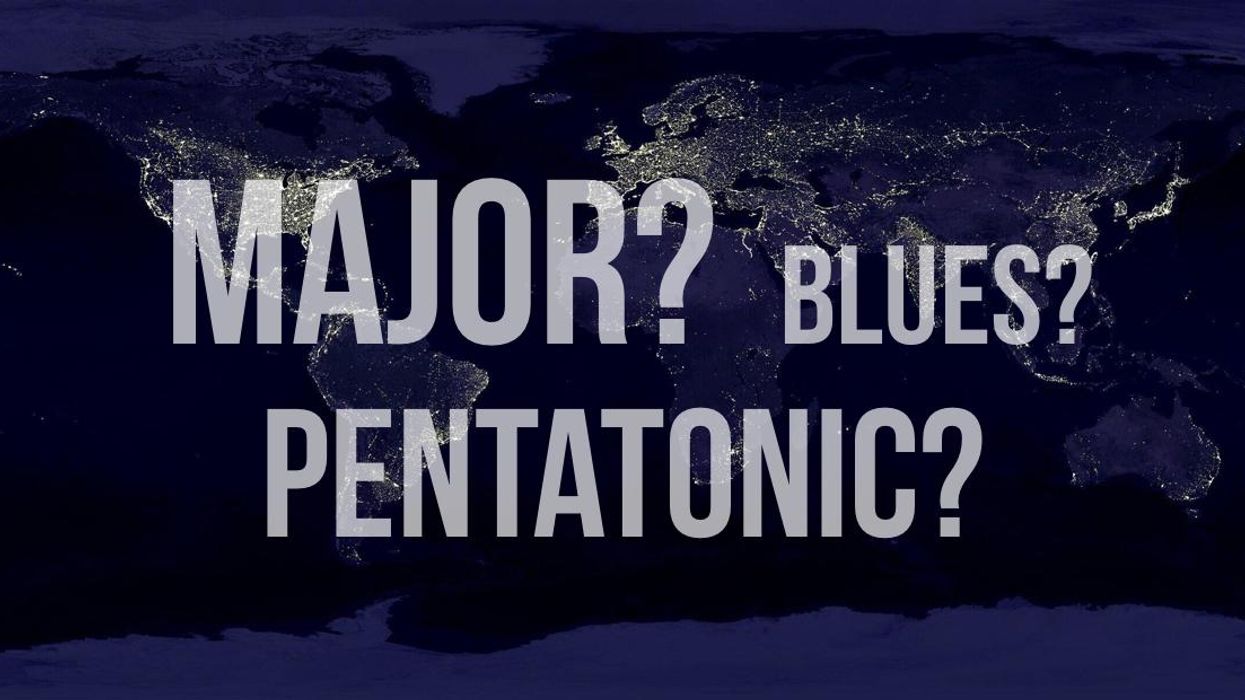Chops: Beginner Theory: Beginner Lesson Overview: • Demonstrate several uses for the major pentatonic scale. • Explore different forms of world music. • Highlight techniques that will give your guitar playing a more cosmopolitan sound. Click here to download a printable PDF of this lesson's notation. |
While many guitarists are aware of the minor pentatonic scale's use in blues and rock music, it's the major pentatonic that is known the world over. Or is it? In this lesson we'll span the globe searching for the prevalence of the major pentatonic.
The Global Scale?
The major pentatonic scale, (Ex. 1), is regularly cited as one of the most ancient and commonly used scales in the world. But is it true? While I have found several examples that highlight the use of the major pentatonic in music across the globe, there are fewer than I imagined. Much more common is the use of various hexatonic, or six-note, scales.
Conceivably, my research for this lesson may have been too limited. Or maybe it's the lack of non-Western music transcribed in standard notation that was a pitfall? If so, I welcome correspondence from readers remedying my shortcomings. But for now, let's investigate a few of the melodies that prove the claim true (if more limited than I thought when taking on this lesson).
China
The first destination on our global journey is China and the 18th-century folk song “Jasmine Flower" aka “Mo Li Hua." This song has lyrics, but it is also performed as an instrumental. As with all the examples in this lesson, the first performance, shown in Ex. 2, features a stylized version of the melody. In this case, I have recorded it on an electric guitar using volume knob swells and an exaggerated vibrato, doing my best to emulate an Erhu, a two-string bowed instrument akin to a violin. This first version uses the G major pentatonic scale (G–A–B–D–E). The second version, (Ex. 3), is a simplified performance using the C major pentatonic scale (C–D–E–G–A).
Click here for Ex. 2
Click here for Ex. 3
Thailand
Up next on our world tour is Thailand and the traditional song “Ngam Sang Duan," which is used for a Thai dance. This melody is typically sung with lyrics, accompanied by xylophone. Ex. 4 features tremolo picking, using the Eb major pentatonic scale (Eb–F–G–Bb–C), imitating a xylophone performance. Ex. 5 is a basic rendition using the C major pentatonic scale.
Click here for Ex. 4
Click here for Ex. 5
India
And we're off to India, playing “Vara Vina" aka “Vara Veena" a Geetam, the simplest form in Carnatic music, one of the two subgenres of Indian classical music. Like the previous melodies, this one is both sung and performed instrumentally. To honor traditional sitar technique, Ex. 6 is performed on one string (still using the pentatonic scale, though that may be difficult to discern), with exaggerated vibrato, plentiful slides, and an A drone accompaniment. Ex. 7 is a rudimentary interpretation using the C major pentatonic.
Click here for Ex. 6
Click here for Ex. 7
Ireland
The closing stop on our international expedition brings us to Ireland and “Peg Ryan's Polka," a jaunty little dance tune (Ex. 8). The D major pentatonic (D–E–F#–A–B) includes a few ornamental 16th-note flourishes and unexpected syncopations, whereas Ex. 9 is a plainer, though nonetheless sprightly, reading out of C major pentatonic.
Click here for Ex. 8
Click here for Ex. 9
As you can see, the major pentatonic does indeed span the globe. Nevertheless, I was surprised to find that it's not the major pentatonic per se but variations, including the minor pentatonic, the so-called Japanese pentatonic, Dorian pentatonic, the Ambassel scale of Ethiopia, a few pentatonic scales that don't conform to the Western tuning system (Javanese in particular), and the aforementioned hexatonic scales that appear to be more prevalent. That realization, rather than discouraging this lesson, led me to be as transparent as possible regarding my research findings. And, more importantly, it fed my interest in learning more about different cultures and their music. I hope you'll continue to explore as well. Bon voyage!



















